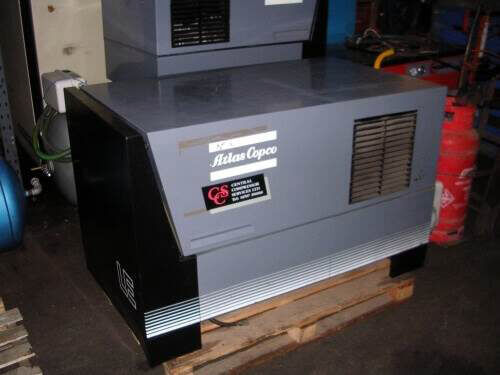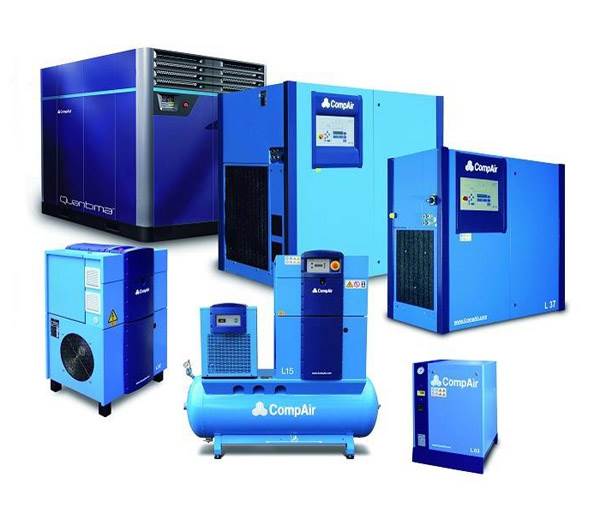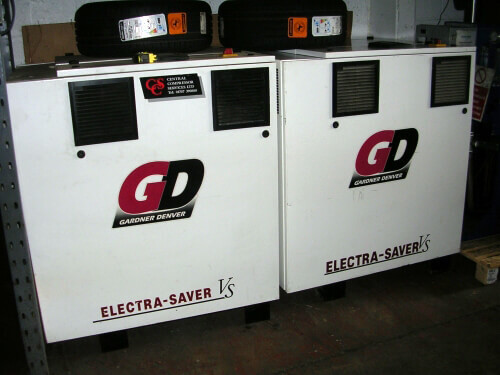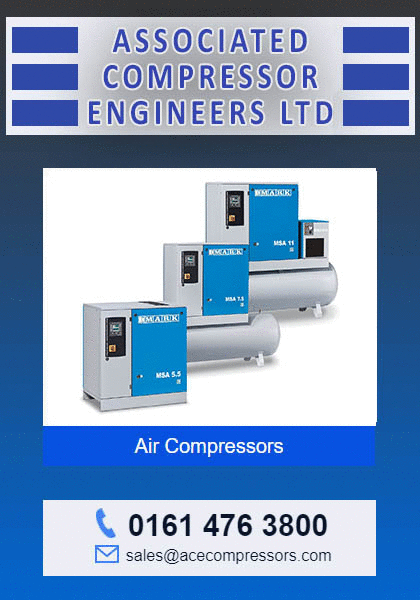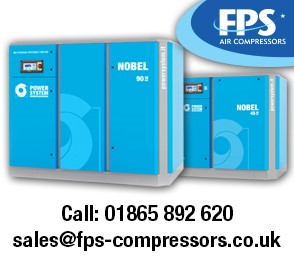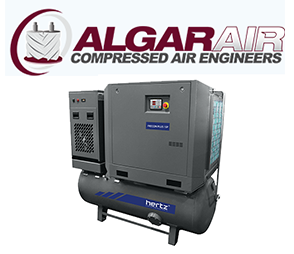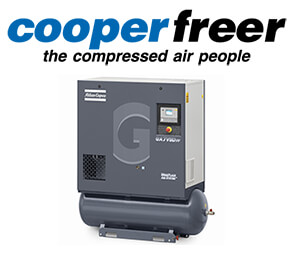- Contact 0870 350 7767
- |
- Advertise
Compressors Guide
Industrial and Commercial
For 15 years Businessmagnet has been promoting and supporting Compressor manufacturers and distributors.
Many types of air compressor exist for a wide array of applications. Compressors for DIY, hobbiests, semi-professional to large scale industrial uses can be provided by our advertisers. Light load reciprocating compressors, full scale constant load screw compressors and high flow centrifugal compresors will suit the most demanding of industry. Compressor servicing, also a major factor to many installation can be sought from many knowledgeable companies. Cost savings can be achieved through the use of reconditioned or second hand compressors that could translate into thousands of pounds in savings.
Popular compressor pages
Air Compressors Guide
Introduction
It is without doubt that the complexities of obtaining, servicing and specifying a compressor for industrial scale applications go well beyond the scope of this article. Compressors from the smallest to largest are supplied by the customers we promote and their expertise will surpass what we can offer by way of this guide. Compressors are so varied in fact that many companies only deal with certain types or applications making the subject all the more confusing. Many compressor buying guides exist that highlight some great points where a small diy or small workshop customer may harvest some information. We understand that many of our compressor based companies are supplying into demanding application requirements and environments and provide a broad guide that touches on some of the technologies that specialist buyers may come across for industrial and large scale implementation. This guide will touch on the various buzz words and compressor types that are familiar throughout the industry and may help those that are considering buying a compressor or even point them in the right direction to a supplier on Businessmagnet. We have been promoting the compressor industry for 15 years and have some very reputable national and international compressor suppliers and designers. For applications such as car garages, spray booths and engineering compressed air lines, CNC tools, the task of finding a suitable compressor/s will be easier than large scale multi compressor installations that will require specialist planning and design.
Lets Talk some Jargon...
Pressure
This is usually expressed in Pounds per square inch or (PSI). Bar is also
another measurement of pressure commonly used.
Air Flow or Output
Flow of air from the compressor will usually be given in a measurement of
volume. The volume of air is the amount of air that will be provided by the
compressor. Free air delivery or (FAD) measured in Litres per minute (L/min) or
cubic feet per minute (CFM) are going to be commonly quoted figures especially
with reciprocating piston compressors. The pressure at which a given volume of
air can be pushed out by the compressor will greatly affect its application.
Free Air Delivered at (pressure) is one of the more important factors we must
know when specifying a compressor.
Displacement
The capacity of a compressor is a theoretical measurement derived from the
displacement provided by the pumps cylinders and the speed they can operate.
Displacement on its own cannot be used reliably to estimate the power of a
compressor.
Working Pressure
For a compressor to operate correctly, it will require a suitable working
pressure, also measured in PSI or Bar
Noise Level
Depending on the application, noise levels may or may not be a consideration.
Dba is the usual figure quoted but may be accompanied by distances and multiple
Dba levels at each distance.
Duty Factor
Compressors are designed for such a wide range of applications, the duty rating
which is the amount of time the compressor will run can be almost infinite.
Tank Size (Receiver size)
Compressors most commonly carry a tank where air is pressurised. For commonly
used compressors this could vary between 5 and 500 litres. Larger tank sizes
will give the compressor more capacity to store compressed air which in turn
will give a longer cycle between charges. During this time, compressors will
expel the air until the pressure reaches a minimum level whereby the compressor
will once again pump to increase the tank pressure. This can be a very important
factor as small operations or quieter environments may prefer to have longer
absences of the noise associated with recharging the tank.
Compressor Types and Applications
There are plenty of terms you will come across when investigating the compressor market; terminology specific to the compressor industry. Compressors can generally be separated into two main principles of their operation in compressing gas or air. Dynamic and Positive displacement compression. Compressors that fall under the positive displacement category include:- Scroll compressors which have a double rotor
- Piston Compressors usually reciprocating
- Rotary Screw compressors which have a single rotor
- Diaphragm Compressors
Dynamic Compressors
Displacement Compressors
Within a positive displacement compressor, a piston moves up and down a
cylinder, much like a combustion engine, compressing the space above, this
results in an increase in pressure. A cavity allows external atmospheric gas or
air into the cylinder chamber which decreases in its size as the piston moves
along the chamber in turn decreasing the volume increasing the pressure.
Positive displacement Piston compressors are particularly useful for high
pressure applications as multiple steps can be incorporated to achieve the
required pressure.
Piston compressors can compress different types of gases depending on their
design which can suit certain applications like refrigerant compression.
Rotary screw compressors sometimes referred to as helical screw compressors are
a little more specialised. Two rotors rotate that mesh together like two screws,
air is trapped and sealed with a coating or oil between each of the rotors. The
air is pushed along into an ever decreasing space increasing in pressure until
it can be contained in a compression chamber. Rotary compressors come in a few
varieties like scroll, vane and liquid ring. The theory remains similar but
within a scroll compressor, only a single spiral axle oscillates against another
spiral which remains fixed. As with a rotary screw compressor, the air is
trapped and becomes smaller until it has sufficiently decreased in volume to
increase pressure.
A constant flow at a specified pressure can be achieved with a displacement
compressor and within the industry, the term constant flow compressor and
displacement compressor are sometimes used interchangeably.
Diaphragm compressors are well suited to applications particularly sensitive to
contamination. A flexible disc oscillates expanding and contracting the volume
of air within a compression chamber. Like an aquarium air pump they operate on a
principle that requires no lubricant. Diaphragm compressors are not suited to
higher capacity uses, but where a very clean air is needed they are normally
found in laboratories or pharamacitical settings as opposed to industrial high
flow applications.
Here are some of our customers that will provide further help in specifying a
displacement compressor
see here
Compressors are used throughout a whole host of industrial applications and have
inherited technology similar to that used in other high tech scenarios, like the
jet turbine of a passenger plane. Here dynamic compression used through axial
compressors is very much at home. In the context of this guide though, we are
more likely to discuss radial dynamic compressors, turbo compressors, with
centrifugal being their more generic names. Impeller technology is used which
accelerates the gases which then slow the faster moving gas/air into a vessel or
volute that transfers this energy into pressure. Axial and radial compressors
tend to produce lower pressures and so require multiple stages to produce the
required pressure.
Centrifugal or turbo compressors are excellent choices for use within chemical
and petrochemical scenarios. Gases commonly used in industry for metal
processing plants are commonly compressed using a dynamic compression system.
The speed in which air can be compressed makes these compressors ideal where
very high volumes of compressed air or gas are required.
We can only touch upon the technology here, but some of our customers listed
will be able to assist with your project.
Fixed Speed and Variable Speed
Energy saving and the environment extends to the compressor industry. Just like
vehicles, compressors can be more or less efficient in the way they achieve the
same result.
Fixed speed compressors run at a steady fixed pace and are ideal when we require
all of their capable load. However, this fixed speed is inefficient and wasted
when the compressor is not being used and is coming to an unloading phase or
stop. Various energy saving devices are employed to lessen consumption but
ultimately the end result will almost always result in an inefficiency.
Variable speed driven compressors or VSD will rotate the compressor dependant on
the demand or to put it another way; they will slow down and speed up relative
to the air required which makes them much more efficient. Some of our customers
will be able to offer a comparison between your application and these two
technologies to produce a more detailed analysis.
Oil and Oil Free
From the small DIY or workshop application right through to industrial
refineries, Oil vs Oil free will be a requirement with different benefits
depending on the aim. On the one hand we have the small 50 litre oil free
compressor that reduces maintenance, on the larger or specialist scale,
applications could be more concerned with the quality of air being supplied
which in certain circumstances could be a factor determining the use of oil as a
seal or lubricant.
Many air compressors use oil within the compression chamber which may be used
for cooling, lubrication or pressure sealing. Within use, minute droplets of
lubricant will ultimately carry into the gas or air working its way through the
compressor network – ultimately ending up to varying degrees within the product
being manufactured or serviced. Filters can be employed to a prevent some of
this contamination but not all. Oil free compressors abandon the use of oil
altogether ensuring that nothing other than the compressed air reaches the
outlet or tool.
Costs increase with oil free technology, especially between comparative
specifications in large industrial applications. Oil free compressors are likely
to employ the use of permanent coatings that act as lubricants like Teflon.
There are some savings to be made throughout their lifecycle with less of a
requirement for replacement filters, oil etc. Some of the companies we advertise
were the first to bring oil free technology to the industry.
We hope you enjoyed this brief guide and encourage you to explore some of the
Air compressor suppliers we promote here on Businessmagnet.


